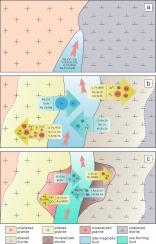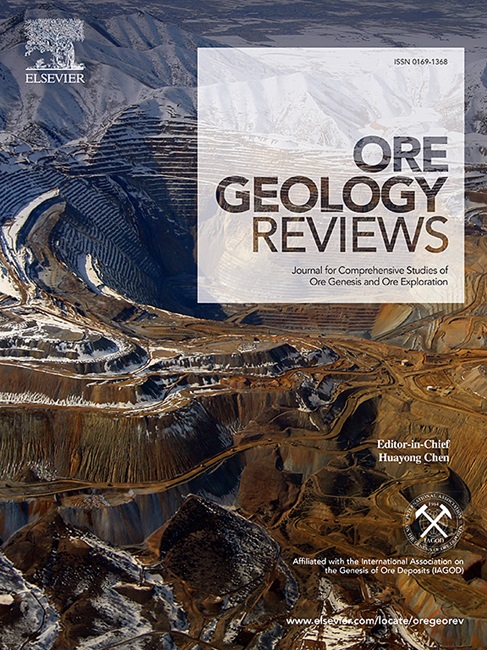Quantifying element mass transfer in the Jiling Na-metasomatic hydrothermal uranium deposit, Northwest China
IF 3.2
2区 地球科学
Q1 GEOLOGY
引用次数: 0
Abstract
The Na-metasomatic hydrothermal uranium deposits are relatively widespread, low in grade (less than 1 % U3O8) but high in tonnage. Although it has been considered that this type of deposit was formed due to hydrothermal alteration unrelated to magmatic activity, the detailed evolution of fluids and ore-forming process are still not well understood. Through element-mass-balance calculation and geochemical mapping of regional rocks, we investigated the Jiling uranium deposit in northwestern China and evaluated the composition and source of fluids and element-transfer behavior through Na-metasomatism and uranium mineralization. The findings show that, in the early Na-metasomatism stage, the Na-, HFSE- and REE-rich late-magmatic hydrothermal fluids caused Na-metasomatism of wall rocks, enriching Na2O (>53 %) while removing K2O (<-78 %), depleting SiO2 (30 % in granite and 3 % in diorite), and massively mass-transferring Fe, Ti, P and some incompatible elements. With increased rock permeability and the formation of partial Fe2+-bearing minerals, the Na-metasomatic alteration produced reducing agents and migration channels for ore-forming fluids, as well as the creation of ∼ 15 vol% porosity in the altered granite for metallogenic space. In the late uranium mineralization stage, CO2-rich fluids extracted uranium and HREEs, converted Fe2+ to Fe3+, and subsequently precipitated uranium to form pitchblende with apatite, calcite and chlorite. Thus, the Na-metasomatic alteration caused by late-magmatic hydrothermal fluids is critical for the production of large Na-metasomatic hydrothermal uranium deposits. Our new geochemical mapping reveals that the mass-concentration changes of Na, K and Si are more credible to defining Na-metasomatic alteration, while Fe, Ti, P, ∑(Zr-Hf-Nb-Ta) and ∑LREE/∑HREE vary strikingly during the uranium mineralization process.

中国西北金陵纳-金属热液铀矿床元素质量转移定量分析
钠-金属热液铀矿床分布较广,品位较低(八氧化三铀含量低于 1%),但吨位较大。虽然人们一直认为这类矿床是由于与岩浆活动无关的热液蚀变形成的,但对流体的详细演化和成矿过程仍不甚了解。通过元素质量平衡计算和区域岩石地球化学绘图,我们对中国西北部的金岭铀矿床进行了研究,评估了流体的组成和来源,以及元素通过钠-金属锍化和铀矿化的转移行为。研究结果表明,在早期Na-金属化阶段,富含Na-、HFSE和REE的晚期岩浆热液引起了岩壁岩石的Na-金属化,富集了Na2O(53%),同时去除K2O(-78%),贫化了SiO2(花岗岩中为30%,闪长岩中为3%),并大量转移了Fe、Ti、P和一些不相容元素。随着岩石渗透性的增加和部分含 Fe2+ 矿物的形成,Na-金属蚀变产生了还原剂和成矿流体的迁移通道,并在蚀变花岗岩中形成了 15 Vol%的孔隙度,为成矿空间提供了条件。在铀成矿晚期,富含二氧化碳的流体提取了铀和 HREEs,将 Fe2+ 转化为 Fe3+,随后铀与磷灰石、方解石和绿泥石沉淀形成黝帘石。因此,晚期岩浆热液引起的Na-金属蚀变是产生大型Na-金属热液铀矿床的关键。我们新绘制的地球化学图显示,在铀矿化过程中,Na、K和Si的质量浓度变化对确定Na-金属蚀变更为可信,而Fe、Ti、P、∑(Zr-Hf-Nb-Ta)和∑LREE/∑HREE则变化显著。
本文章由计算机程序翻译,如有差异,请以英文原文为准。
求助全文
约1分钟内获得全文
求助全文
来源期刊

Ore Geology Reviews
地学-地质学
CiteScore
6.50
自引率
27.30%
发文量
546
审稿时长
22.9 weeks
期刊介绍:
Ore Geology Reviews aims to familiarize all earth scientists with recent advances in a number of interconnected disciplines related to the study of, and search for, ore deposits. The reviews range from brief to longer contributions, but the journal preferentially publishes manuscripts that fill the niche between the commonly shorter journal articles and the comprehensive book coverages, and thus has a special appeal to many authors and readers.
 求助内容:
求助内容: 应助结果提醒方式:
应助结果提醒方式:


